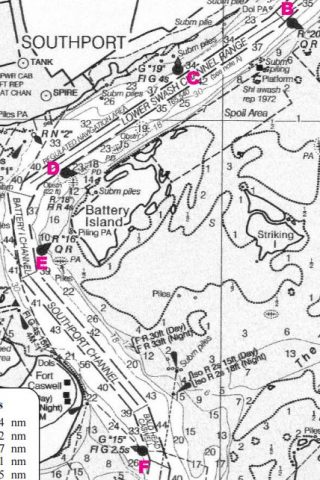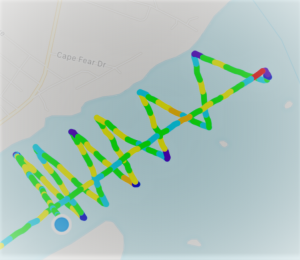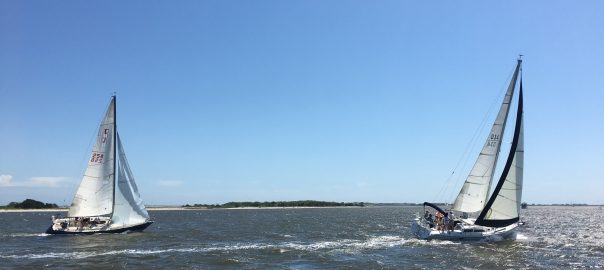As a guest of the Cape Fear Yacht Club, I sailed in the first season PHRF 1, races 1 and 2. Crewing on a Catalina 22 it was a blast from the past. Defining the past; that would have been the Mile High Regatta in 1979 on a Hobie 16 (Fleet 62). It brought back many memories of the excitement and challenges although I’m not quite as nimble these days and my recall of racing rules a bit rusty.
Today’s venue was the Cape Fear River very near to its entrance to the Atlantic Ocean. Tidal current was a definite consideration as I shall explain. The course start line was between race mark “D”  and the committee boat. We crossed that line into the teeth of 10 gusting 15 knot SW breeze. The route cleared race mark “E” and continued on to pass by Fort Caswell to round mark “F” to starboard. There was a barge under tow in the Southport Channel but timing was such that our starboard tack allowed us to cross ahead and maintain safe buffer without interference. The next mark to round was “B” so back to toward “E” on a port tack before reaching to pass “D”, followed by a wing on wing run downwind along the Lower Swash Channel Range. We held our own here and moved right along even though carrying a reef in the main and only a 90% jib. After rounding “B” it was a hard slog to the finish line beating down channel. The previously mentioned current was against us and this is where we blundered. Forecast Flood was to peak at 3 knots by mid afternoon. You can see from the trace the effect that it had. The close hauled legs at the “B” mark end shows adequate course made good. As time wore on observe
and the committee boat. We crossed that line into the teeth of 10 gusting 15 knot SW breeze. The route cleared race mark “E” and continued on to pass by Fort Caswell to round mark “F” to starboard. There was a barge under tow in the Southport Channel but timing was such that our starboard tack allowed us to cross ahead and maintain safe buffer without interference. The next mark to round was “B” so back to toward “E” on a port tack before reaching to pass “D”, followed by a wing on wing run downwind along the Lower Swash Channel Range. We held our own here and moved right along even though carrying a reef in the main and only a 90% jib. After rounding “B” it was a hard slog to the finish line beating down channel. The previously mentioned current was against us and this is where we blundered. Forecast Flood was to peak at 3 knots by mid afternoon. You can see from the trace the effect that it had. The close hauled legs at the “B” mark end shows adequate course made good. As time wore on observe  that the zigzag legs compress with very little gains. (the center line down the middle was the downwind leg straight from “D” to “B”)
that the zigzag legs compress with very little gains. (the center line down the middle was the downwind leg straight from “D” to “B”)
I saw the trace of our closest competitor after the fact and analyzed that he used a different strategy. After the first 2 long tacks to mitigate the effects of current he avoided the Northern side basically by staying south of that downwind track that we did; short tacking all the way.
Presumably the current was less when close to Battery Island and strongest between the Southport shore and the deep water in the channel of our downwind track. Smart competitor and now we know better.
